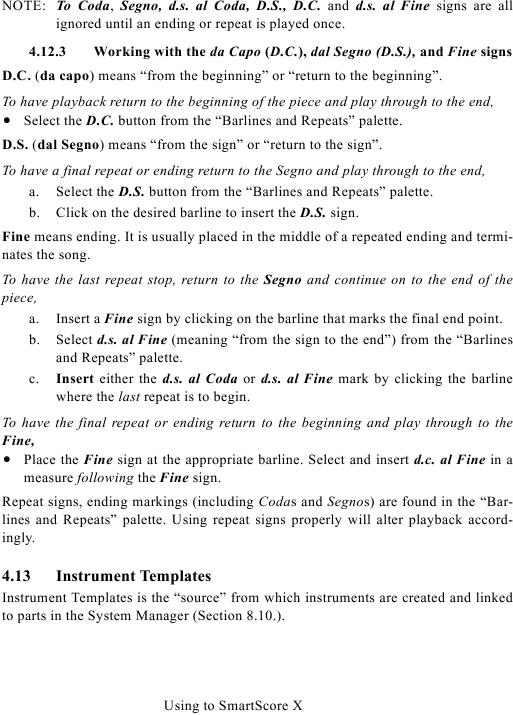NOTE: To Coda, Segno, d.s. al Coda, D.S., D.C. and d.s. al Fine signs are all
ignored until an ending or repeat is played once.
4.12.3
Working with the da Capo (D.C.), dal Segno (D.S.), and Fine signs
D.C. (da capo) means "from the beginning" or "return to the beginning".
To have playback return to the beginning of the piece and play through to the end,
· Select the D.C. button from the "Barlines and Repeats" palette.
D.S. (dal Segno) means "from the sign" or "return to the sign".
To have a final repeat or ending return to the Segno and play through to the end,
a. Select the D.S. button from the "Barlines and Repeats" palette.
b. Click on the desired barline to insert the D.S. sign.
Fine means ending. It is usually placed in the middle of a repeated ending and termi-
nates the song.
To have the last repeat stop, return to the Segno and continue on to the end of the
piece,
a. Insert a Fine sign by clicking on the barline that marks the final end point.
b. Select d.s. al Fine (meaning "from the sign to the end") from the "Barlines
and Repeats" palette.
c. Insert either the d.s. al Coda or d.s. al Fine mark by clicking the barline
where the last repeat is to begin.
To have the final repeat or ending return to the beginning and play through to the
Fine,
· Place the Fine sign at the appropriate barline. Select and insert d.c. al Fine in a
measure following the Fine sign.
Repeat signs, ending markings (including Codas and Segnos) are found in the "Bar-
lines and Repeats" palette. Using repeat signs properly will alter playback accord-
ingly.
4.13
Instrument Templates
Instrument Templates is the "source" from which instruments are created and linked
Using to SmartScore X

